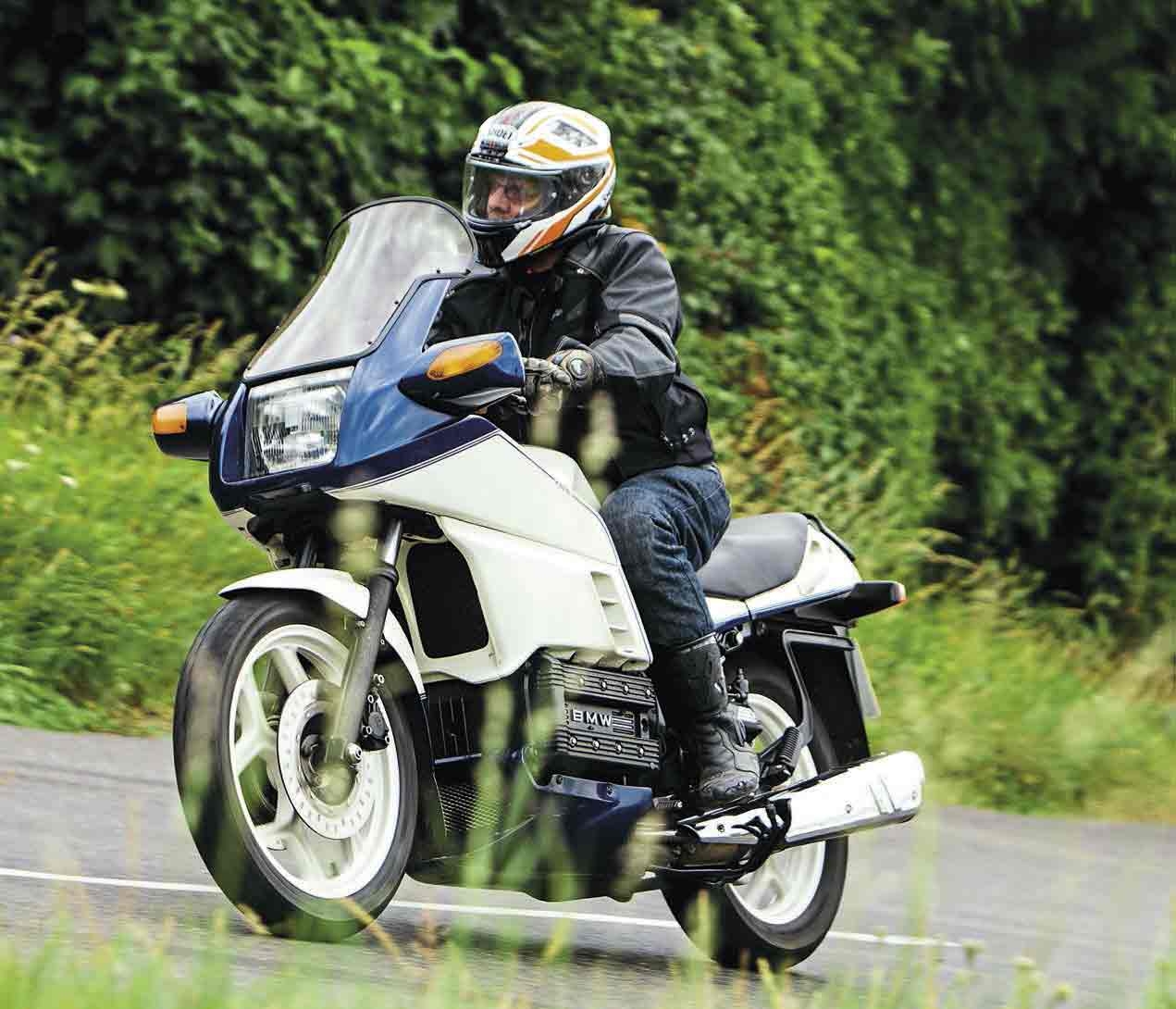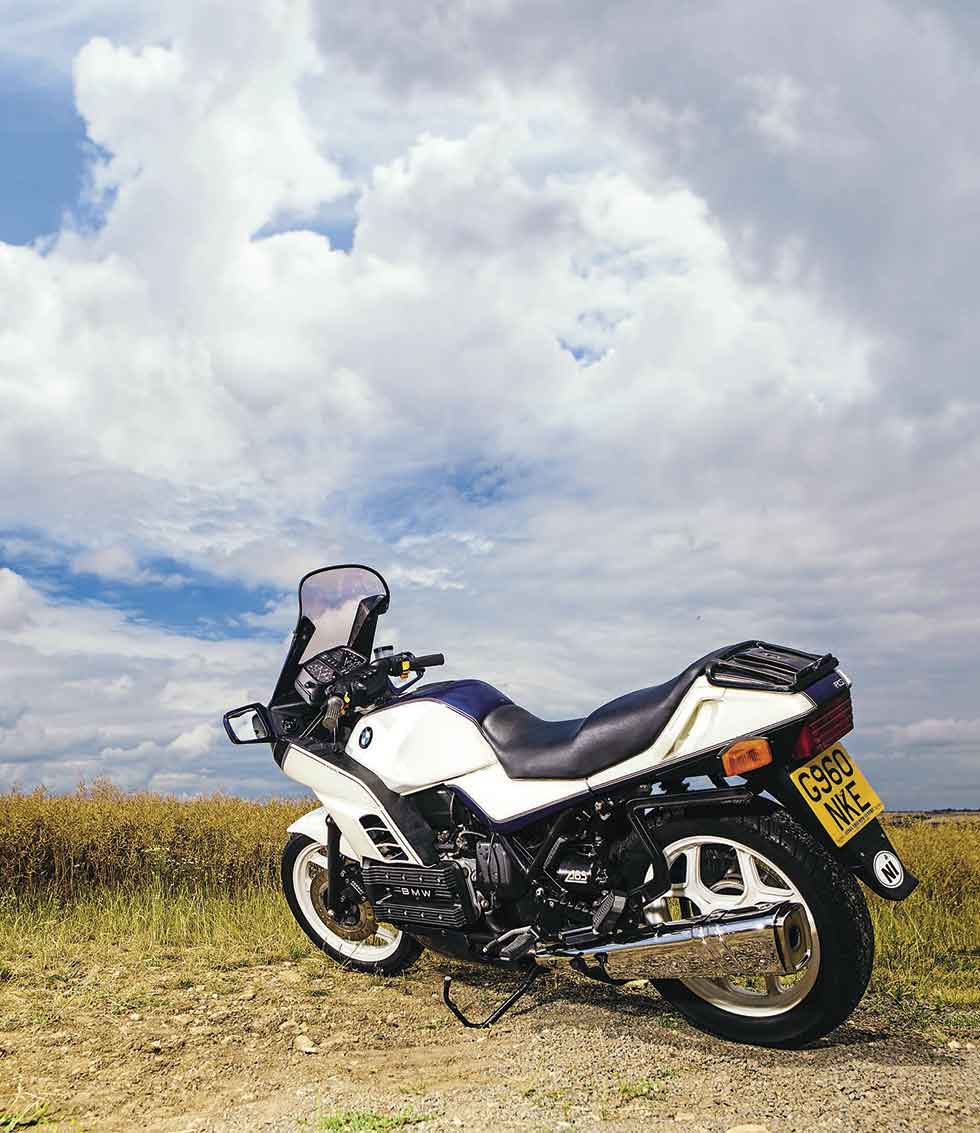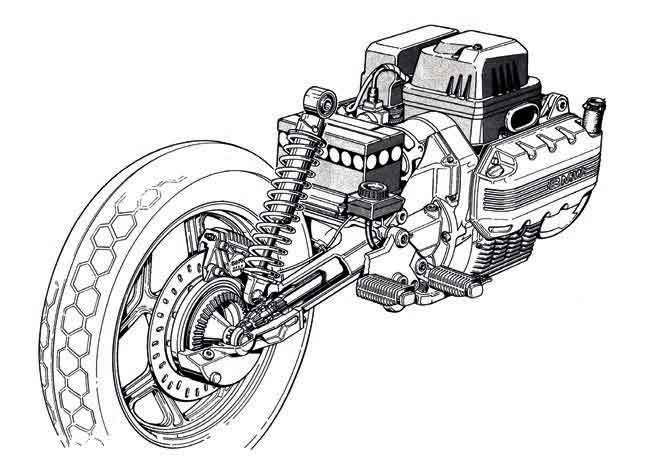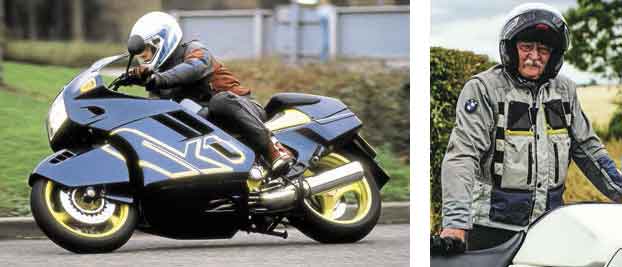
Building Blocks. “Look at that old brick!” Least that’s what Scoop thought they said. Classic Ride BMW K100 RS. BMW took an about-turn from the boxer twin and carved a new niche in Beemer history when it created the legendary Flying Brick. We ride BMW’s K100 RS. Words: Steve Cooper. Photos: Gary D Chapman/Mortons Archive.
BMW K1100 RS 80s Ridden & rated! “This could be the ultimate incarnation of the four-pot K-series motor: the K100 RS SE. Yes, Special Equipment. This brick is both practical and stylish even if uniquely Bavarian in design.”
The bike you see before you represents one of the most fundamental shifts in motorcycle design by a single manufacturer ever. Short of venturing into the world of forced induction two-strokes, BMW could not have opted for a more radically different set-up to that which it had previously championed. And yet the resultant new machine did retain two key features that had traditionally characterised the marque; shaft drive and a low centre of gravity. The new K series Beemers had arrived…

Covered in acres of swooping plastic panel work, ducts and louvres, screen and sculptured seat the bike could almost have come from any of the big Japanese players. Doubtless this is more than mere happenstance; the K’s designers had unquestionably been briefed to ensure the bike had market appeal to aid sales. Yes, the earliest K models looked a little more quirky but they were still light years away from the old established boxer engine bike. By the time the fully-faired variants arrived on the scene there was an unmistakable Oriental theme going on but it was only ever superficial. Both on the surface and beneath it, this BMW was unlike any other motorcycle before or after it.
One of BMW’s long-time unique selling points had been its bikes’ apparent lack of mass; an act of artifice courtesy of the engine and transmission being mounted ultra-low in the frame. Characteristic of the marque, this still had to be a feature of any radically new model yet the German manufacturer nevertheless needed to compete head-on with the manifold offerings from Japan. At the time the prevalent engine configuration was the inline four but BMW couldn’t simply rip-off a layout that was universally recognised as being Japanese in origin, so what other option was there? The smoothness and power offered by the inline four was desirable but not the visual profile, so what to do? If you’re BMW you lay the engine down flat to minimise the C-of-G, then turn it through ninety degrees so it suits your preferred method of final drive, then add water-cooling. Inline fours were nothing new and certainly water-cooled fours had been done before but a flat, water-cooled, inline four? BMW instantly had an exclusive engine configuration and a supremely novel USP.

Our subject matter this month is quite possibly the ultimate iteration of the four-pot K series motor, the K100RS SE; the SE meaning Special Equipment in the guise of fuel and temperature gauges. From any angle the bike is best described as substantial both in the visual and avoirdupois sense. From the side-on aspect the bike is almost a solid entity with little daylight showing through anywhere other than in between the rather stylish eight-spoke cast alloy wheels. Huge expanses of alloy, steel and plastic are evident, and most of that is conventional in purpose if uniquely Bavarian in design.
Obviously the engine is the most ‘different’ object in view yet it doesn’t actually look like a power unit. By the time the K100RS SE was on sale BMW had chosen to almost disguise the flat four with satin black paint covers and the odd discrete decal proclaiming ownership. Behind the motor is probably the largest bell housing-cum-gearbox combo ever fitted to a Beemer which, if nothing else, keeps the rear drive shaft relatively short. Sitting above and outboard of the transmission close to the pillion rests are a pair of black, vaguely cylindrical objects that form the dual hearts of the anti-lock braking system aka the ABS.
Looking at these relatively large lumps of early motorcycle safety technology makes you realise just how the science has moved on but when the K was new this was cutting edge stuff. In fact at this point in motorcycling history it was still an open-ended question as to whether the concept was even of real practical value, let alone commercially viable.
Elsewhere the bike is essentially a pure carbon copy of standard Bavarian Bayerische Motoren Werke AG fare, just in a more modern guise. Having pioneered manufacturer-fitted fairings back in the 1970s with the R90S, you’d expect the plastics on this much later model to be finely executed and they are. Much effort was expended on making the bike as smooth and aerodynamic as possible and a head-on or three quarter profile shows just how sleek the bike is for a one litre machine.
Fitting the mirrors with the front indicators is a perfect example of BMW utilising available free space while at the same time not adding one iota to the machine’s frontal area. Inside the cockpit there’s a plethora of instruments, readouts, idiot lights and the like yet, in that typically Teutonic way, everything makes sense once you grasp its purpose and/or function. The only minor aberration to this almost flawless logic is the apparently crazy setup for the indicators’ activation with individually operated thumb switches on both bars – they’ve only recently given up on such a weird system. Anyone new to the layout would be well advised to literally play with the various buttons, levers, sliders and toggles before embarking on a ride. Ultimately and predictably everything makes perfect sense and soon becomes second nature in use but the indicators are a little counterintuitive.
If you have ridden flat twin Beemers before then the first thing you notice is the marked absence of cylinders in front of your shins. And in fact if you’ve ridden any transverse four before you are also in for a surprise; the K100 is a remarkably narrow motor. It may seem trite, hackneyed or clichéd but as this is a piece of Germanic engineering everything does, automatically, fall perfectly to hand in terms of the bars, the seating position and the foot pegs; someone spent a lot of time getting this part of the bike just right and much else besides… Which is a shame because I’ve almost given myself a hernia trying to get the bike off the stand; I’m almost banjaxed by the effort it takes. BMW has thoughtfully supplied a lifting handle to get the bike back on or off the stand but, in my humble opinion, it is more window dressing than practicality. When Honda could produce bikes that would almost jump up on their stands at will back in the 60s, remain stable at rest yet were paragons of virtue to get back on their wheels I wonder how anyone, especially BMW, can make a simple task so damn difficult. Oh, and the side-stand is a pain to find when you’re sitting on the bike. One is a simple case of lever/ pivot/fulcrum, the other a careless oversight.
Being fuel-injected there’s no choke to jiggle about and with the ignition on it’s just a case of pressing the green button atop of the kill switch. The motor instantly leaps into life with a unique and subdued rustle. Clutch in and first gear selected the bike is off and away in a manner you don’t historically associate with older Beemers. In fact the unique motor is a bit of a lout on the quiet, egging the rider on to increase throttle and speed.
Quite possibly not inimitable but singularly rare, the motor’s piece de résistance is torque and huge great dollops of the stuff. You are urged forward by that flood of twisting, turning, surging ability supplied in an almost laissez faire manner. Short shifting the easy to use box becomes the norm and then suddenly you look at the speedo and think: how bloody fast? Very much in the manner of the large capacity Honda VFRs the K100 mill gets you up there and hurtling along much faster than you’d expect. The only slight ‘at odds with the BMW experience’ is the typical four-cylinder engine buzz that comes through the foot pegs from time to time.
All of this happens once you’ve got some heat into the motor, which takes some time to accomplish given just how much mass there is, but once warm it stays warm. At the front of the K there’s a radiator as you’d expect which presumably vents its excess thermal energy out via the louvres at the rear edges of what’s ostensibly a half fairing. All of this works as it should and at speed you’d not notice a thing. However, the radiant and convected heat from the motor is a different thing unless you’re going fast and even then it can still make the rider rather toasty: which won’t be a bad thing if it’s winter but I’d not be choosing a fully fitted K100 for a trip to the south of France come July. Our test bike wears a belly pan and I can’t help but wonder if this somehow plays havoc with heat dissipation.
What’s not up for debate is the way in which the bike so easily dispatches miles. Once beyond walking pace the bike’s a paragon of virtue with negligible shaft drive effect despite crass attempts by today’s pilot to get a noticeable reaction. Even ham-fisted and inappropriate down-changes fail to evince the sort of response you’d have expected and received from an old school Guzzi. The only foible the bike occasionally throws up is an almost random shimmy from the front end when encountering certain road imperfections. The Bridgestone BT45s are fresh and at the correct pressures, yet once every so often there’s the briefest moment of uncertainty to the bike, one which you get used to.
The K100RS becomes more and more addictive proving to be a real hoot to ride around the winding trunk roads of Oxfordshire. The narrow bars that were decidedly lacking in leverage when manoeuvring the bike around at walking pace are now perfect for the job in hand.
That apparently minimalist seat is actually pretty much ideal and cants you forward just enough so you’re not sitting bolt upright. This in turn leans you forward onto those bars but there’s no wrist ache apparent. And this is part of what you’re buying into with the BMW brand; countless hours of unseen research and development that makes your riding experience so much better. I get this, in fact I begin to embrace it but one thing I cannot forgive is the screen dimensions. At 5ft 10in I’m pretty much average height and build and the screen does a superb job of taking the wind off my torso yet the upper edge of the same unit buffets the top of my helmet like merry hell. Duck down and the pummelling stops; raise my head up and the wind just does what it’s normally does: strange.
The suspension system is set for the plush side of functional as befits its role of what we’d now term ‘sports tourer’. The front dips down under braking yet not dramatically so but it similarly doesn’t uncontrollably pogo back up either. The rear end runs a single side swing-arm allied to a single shocker and together they do a damn fine job, no more needs to be said. Braking-wise the K runs period top end Brembo calipers augmented by that early ABS system. I have to go on record as saying the system worked faultlessly with no clumsy first-generation, nanny state, ‘I-know-better-than-you’ inference. Unless you’d clocked the ABS units you’d never know the bike was anything other than conventionally retarded.
BMWs have always been different to mainstream motorcycles and the K100RS is no exception. It shares traits and values of its twin pot predecessors yet it is fundamentally dissimilar to them. The K-series was and remains a brave, courageous and ultimately commercially successful venture, so it’s perhaps the most supreme of twin ironies that we now have Beemers that have little if anything in common with the early K-series machines as shown by the S series transverse fours. That said you might well argue they learnt a lot from the Ks and perhaps it was this that put them once more on the rostrum of the TT.
Tech and photos
SPECIFICATION
ENGINE TYPE 987cc liquid-cooled, four stroke, DOHC, four-valve, four-cylinder
BORE AND STROKE 67 x 70mm
CLAIMED HORSEPOWER 90bhp @ 8000rpm
MAXIMUM TORQUE 63lb-ft @ 6000rpm
TRANSMISSION TYPE 5-speed, shaft final drive
COMPRESSION RATIO 10.2:1
CARBURETION Bosch LE fuel injection
TYRES 100/90V 18 (F), 130/90V 17 (R)
FUEL CAPACITY 4.8 gallons (22 litres)
BRAKES Disc x 3 ~ (285mm)
OVERALL LENGTH 2200mm (87.4in)
OVERALL WIDTH 800mm (31.5in)
WHEELBASE 1516mm (59.7in)
WET WEIGHT 249kg (584lb)
“This unique motor is a bit loud (on the quiet!). It eggs-on the rider to increase throttle and speed. The motor has huge great dollops of torque.”
Almost unique, almost a legend? Clean pipes and the tell-tale ABS system. Cockpit as well-appointed as a rep-mobile.
The flat four K series history
The horizontal flat engine BMWs ran from 1983 to 1993 and were designed to get ‘buy in’ to the famous blue and white roundel from riders who would never have considered a flat twin. The naked K100, often called The Flying Brick, was BMW’s first major move away from the boxer engine. In quick succession followed the K100 RS (1983) and K100 RT (1984) aimed at sports and touring riders respectively.
The K100 LT was arguably something of a lily-gilding exercise whereby BMW tried to poach customers away from the Gold Wing scene. Initially sold with two valves per cylinder the bikes ran 16 valves around the 1987 model year; both engine types ran double overhead cams which was another first for the brand on a road bike.
The final hurrah for the Flying Brick was the K1 series (1989-1993) which saw BMW producing a machine close in concept if not in outright performance to the Japanese sports bikes.
With massive front guards, aerodynamic fairings and seat cowls these bikes were targeted at riders who wanted to use the 140mph performance available. Very much a niche market machine, due in no small way to the outlandish paintwork, the K1 remains a Marmite bike to this day.
As almost every Beemer before it, the K100 spilt opinion with some welcoming the changes from the traditional set, while others felt it all to be a step too far. What few argued about was the K100’s smaller sibling; the three pot K75 introduced in 1985.
Initially sold as a naked the bike gained a cockpit fairing to become the K75C in 1985, gained a sports fairing a year later to be the K75S and finally a touring fairing in 1991 becoming the K75 RT. Those that have ridden both the 1000 and the 750 reckon the latter is the easier machine to live with long-term.
K1 is something of a classic.
BMW’s circuitous route to the K-series flat four
By the mid 1970s BMW knew it had to broaden its horizons if the motorcycle division was to remain functioning and in profit. The previous move from almost handmade to mass produced motorcycles helped – but only to a point.
The car division was overtly selling high-end products to an affluent yet wide market and the bikes needed to move in the same direction. A new engine was required if the company was to survive. It was Josef Fritzenwenger who led the way with the then radical notion of flat-four engine coupled to an engine speed clutch and shaft drive.
Retaining the trademark transmission system dovetailed in nicely with the market BMW was still targeting and the use of a flat four motor retained the low centre of gravity that was traditionally associated with the brand.

The only question was how to go about the genesis of the new engine. Proof of concept came via the adaptation of a Peugeot 104 car engine which pretty well matched the basic aims of the project. However, when additional expertise was brought in from the BMW car division the end result was far too large and unwieldy. It wasn’t until early 1979 and with a change in senior management that the K project was injected with new energy. Martin Probst, father of the Volkswagen Golf engine and the BMW Formula II, was put in charge of engine development.
By August 1980 a prototype engine was ready for testing. Fuel injection had been decided upon from the off and Bosch had been chosen as the logical supplier. The peripheral space around the engine was limited which essential ruled out carburettors anyway and Bosch had an ace up its sleeves. Almost a decade before it successfully pioneered and sold fuel injection systems to Volkswagen for the company’s super-compact ‘suitcase’ series engines as installed in all of the Type 4 cars.
That first K motor ran for 10,000 hours and once optimised delivered a healthy 90 horse power. Issues with engine seals, drive shaft couplings and extreme heat generation were all eventually overcome via what was then state-of-the-art computer monitoring; something that was then very rare in the motorcycle engine development world. BMW knew the power unit had to be right first time out and the various engines, installed into new chassis, received hugely rigorous shake downs.
The first pair of prototype machines were made to endure 60,000km apiece of severe riding and the subsequent three upgraded bikes then had to manage a further 30,000km each. Finally, 25 preproduction K100s were built at the Berlin factory in May 1983 and every single one of them was ridden for a fairly staggering 250,000km before BMW felt sufficiently confident to go public with the machine in September 1983.
The owner’s tale: Karl Chadwick
Despite having had three K100s, two RTs and an LT plus a K75RT, I found none of them to be really ‘my sort of bike’. The twin was my real Beemer, yet in 2013 while recovering from a crash on an R1200 I spotted this on the internet.
A gut feeling told me that I had to have it, which is what we tell ourselves, and it was duly purchased. With 28k miles from 1989 it was hardly run in and still rides like a new bike. It was the colour that was the attraction as I had always admired the combination. It rides beautifully, different from all my previous Ks. The pearl white luggage came with it and last year I took it to northern Spain and on the mountainous roads it rode a treat.

The grunt from what is an automotive engine proves a hell of a bonus; just open the throttle at low speeds and it’s away. Fuel economy is much better than my RRS, which has tramped the same roads, and the aforementioned grunt makes it a lot of bike for half the cost of the R. Therefore it’s very much another keeper.





